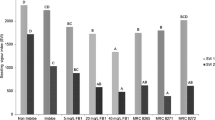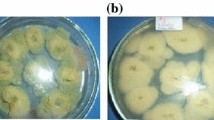Abstract
The cultivation of cowpea (Vigna unguiculata) plays a vital role in the livelihood of many subsistence farmers and rural communities in tropical and subtropical countries. The seeds are prone to fungal infestation and mycotoxin contamination during sub-optimal storage conditions. Fumonisin B1 (FB1), produced byFusarium proliferatum, has been detected in cowpea seeds. Surface-disinfected seeds were imbibed in sterile distilled water amended with FB1 at various concentrations. Percentage germination was determined according to the International Seed Testing Association rules. All the toxin concentrations significantly decreased seed germination and the two highest concentrations — 50 and 100µg ml−1 FB1 — inhibited root and shoot elongation. FB1-treated embryonic tissues evinced compaction of the protoplasm and separation of the plasmalemma from the cell wall. Lipid bodies accumulated, which seemed to be lining the cell wall. This is the first study to demonstrate the phytotoxic effects of FB1 on cowpea seeds.
Similar content being viewed by others
References
Abbas, H.K. and Boyette, C.D. (1992) Phytotoxicity of fumonisin B1 on weed and crop species.Weed Technol. 6:548–552.
Abbas, H.K., Boyette, C.D., Hoagland, R.E. and Vesonder, R.F. (1991) Bioherbicidal potential ofFusarium moniliforme and its phytotoxin, fumonisin B1.Weed Sci. 39:673–677.
Abbas, H.K., Duke, S.O., Merrill, A.H. Jr., Wang, E. and Shier, W.T. (1998) Phytotoxicity of australifungin, AAL-toxins and fumonisin B1 toLemna pausicostata.Phytochemistry 47:1509–1514.
Abbas, H.K. and Riley, R.T. (1996) The presence and phytotoxicity of fumonisins and AAL-toxin inAlternaria alternata.Toxicon 34:133–136.
Adekunle, A.A. and Bassir, O. (1973) The effects of aflatoxin B1 and palmotoxins B0 and G0 on the germination and leaf color of the cowpea (Vigna sinensis).Mycopathol. Mycol. Appl. 51:299–305.
Baird, L.A.M., Leopold, A.C., Bramlage, W.J. and Webster, B.D. (1979) Ultrastructural modifications associated with imbibition of the soybean radical.Bot. Gaz. 140:371–377.
Barrett, J.R. (2000) Mycotoxins: Of molds and maladies.Environ. Health Perspect. 108:A20-A23.
Brader, L. (2002) Foreword.in: Fatokun, C.A., Tarawali, S.A., Singh, B.B., Kormawa, P.M. and Tamò, M. [Eds.] Challenges and opportunities for enhancing sustainable cowpea production.Proc. World Cowpea Conf. III (IITA, Ibadan, Nigeria).
Danielsen, S. and Jensen, D.F. (1998) Relationships between seed germination, fumonisin content, andFusarium verticillioides infection in selected maize samples from different regions of Costa Rica.Plant Pathol. 47:609–614.
Doehlert, D.C., Knutson, C.A. and Vesonder, R.F. (1994) Phytotoxic effects of fumonisin B1 on maize seedling growth.Mycopathologia 127:117–121.
Hasan, H.A. (2001) Phytotoxicity of pathogenic fungi and their mycotoxins to cereal seedling viability.Acta Microbiol. Immunol. Hung. 48:27–37.
International Seed Testing Association. (1999) International Rules for Seed Testing.Seed Sci. Technol. 27 (Suppl.):333.
Kritzinger, Q., Aveling, T.A.S., Marasas, W.F.O., Rheeder, J.P., van der Westhuizen, L. and Shephard, G.S. (2003) Mycoflora and fumonisin mycotoxins associated with cowpea (Vigna unguiculata (L.) Walp) seeds.J. Agric. Food Chem. 51:2188–2192.
Lamprecht, S.C., Marasas, W.F.O., Alberts, J.F., Cawood, M.E., Gelderblom, W.C.A., Shephard, G.S.et al. (1994) Phytotoxicity of fumonisins and TA-toxin to corn and tomato.Phytopathology 84:383–391.
Marasas, W.F.O. (1996) Fumonisins: History, world-wide occurrence and impact.in: Jackson, L.S., De Vries, J.W. and Bullerman, L.B. [Eds.] Fumonisins in Food. Plenum Press, New York, NY.
McClean, M. (1996) The phytotoxicity ofFusarium metabolites: An update since 1989.Mycopathologia 133:163–179.
Merrill, A.H. Jr. (1991) Cell regulation by shingosine and more complex sphingolipids.J. Bioenerg. Biomembr. 23:83–104.
Norred, W.P. and Voss, K.A. (1994) Toxicity and role of fumonisins in animal diseases and human esophageal cancer.J. Food Prot. 57:522–527.
Rheeder, J.P., Marasas, W.F.O. and Vismer, H.F. (2002) Production of fumonisin analogs byFusarium species.Appl. Environ. Microbiol. 68:2101–2105.
Riley, R.T., Voss, K.A., Yoo, H-S., Gelderblom, W.C.A. and Merrill, A.H. (1994) Mechanism of fumonisin toxicity and carcinogenesis.J. Food Prot. 57:638–645.
Seenappa, M., Keswani, C.L. and Kundya, T.M. (1983)Aspergillus infection and aflatoxin production in some cowpea (Vigna unguiculata (L.) Walp) lines in Tanzania.Mycopathologia 83:103–106.
Singh, B.B., Mohan Raj, D.R., Dashiell, K.E. and Jackai, L.E.N. (1997) Advances in Cowpea Research. Copublication of International Institute of Tropical Agriculture (IITA) and Japan International Research Center for Agricultural Sciences (JIRCAS), Ibadan, Nigeria.
Sperling, P. and Heinz, E. (2003) Plant sphingolipids: Structural diversity, biosynthesis, first genes and functions.Biochim. Biophys. Acta 1632:1–5.
Thiel, P.G., Marasas, W.F.O., Sydenham, E.W., Shephard, G.S., Gelderblom, W.C.A. and Nieuwenhuis, J.J. (1991) Survey of fumonisin production byFusarium species.Appl. Environ. Microbiol. 57:1089–1093.
Thomson, W.W. and Platt-Aloia, K. (1982) Ultrastructure and membrane permeability in cowpea seeds.Plant Cell Environ. 5:367–373.
Van Asch, M.A.J., Rijkenberg, F.H.J. and Coutinho, T.A. (1992) Phytotoxicity of fumonisin B1, moniliformin and T-2 to corn callus cultures.Phytopathology 82:1330–1332.
Vesper, H., Schmelz, E-M., Nikolova-Karakashian, M.N., Dillehay, D.L., Lynch, D.V. and Merrill, A.H. Jr. (1999) Sphingolipids in food and the emerging importance of sphingolipids to nutrition.J. Nutr. 129:1239–1250.
Author information
Authors and Affiliations
Corresponding author
Additional information
http://www.phytoparasitica.org posting Feb. 15, 2006.
Rights and permissions
About this article
Cite this article
Kritzinger, Q., Aveling, T.A.S. & van der Merwe, C.F. Phytotoxic effects of fumonisin B1 on cowpea seed. Phytoparasitica 34, 178–186 (2006). https://doi.org/10.1007/BF02981318
Received:
Accepted:
Issue Date:
DOI: https://doi.org/10.1007/BF02981318




